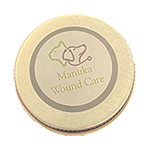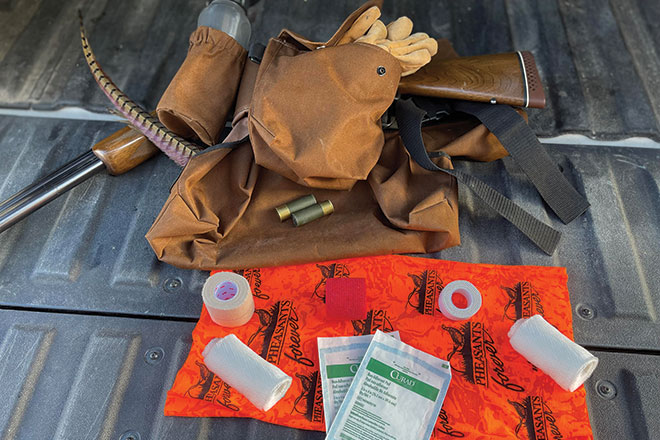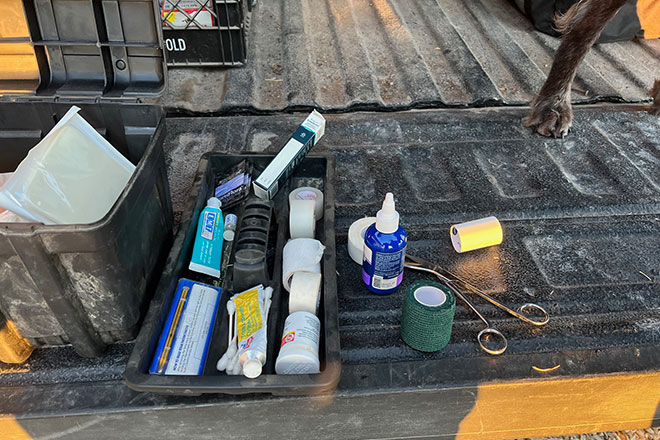Photo by Seth Bynum DVM
Vest kit and truck kit checklists for bird doggers
By Dr. Jay Brekke DVM
One day last September I was descending a Colorado mountain on a ptarmigan and dusky grouse hunt with my friend Jesse, a vet school classmate of mine. Of course, our bird dogs were along. I carried a small canine first aid kit, as I do on most hunts, hoping I would not need it.
We heard a soft whine and turned around. My German shorthaired pointer, Gweny, was leaving a blood-tinged trail along the jagged rocky slopes. She was exhausted and in pain. As both veterinarian and best friend to my injured dog, I knew we needed to quit. Our spike camp was 6 miles away, with an additional 3 miles the next day to our side by-side UTV, followed by an hour-long UTV ride back to my pick-up.

I was relieved that I had packed a small first aid kit with some essential items. Granted, we uplanders and our dogs aren’t always hunting in such extreme environments, but a first aid kit with the items I carry is worth its small amount of weight on a romp for pheasants in CRP grass, on a swing for sharptails … and on a mountain far from nowhere. Jesse and I discussed what to do. Try and carry Gweny? She is only 40 pounds, but 6 miles at 11,000-12,000 feet of elevation would be difficult if not impossible. Return on the same rocky trail, or bushwhack straight down through dense evergreen forest on extremely steep slopes? Another challenging journey.
I closely examined Gweny’s paws. She was bleeding at the nail beds, not the pads, and her feet were swollen as if all four paws were stung by yellow jackets. On the back side of the front paws, I could see that the carpal pad (a.k.a. bumper pad) was very red and irritated, and had abrasions from the sharp rocky trail.
We all needed a rest. We found a grassy slope. Fog lifted and the sun came out. Gweny just needed to get off her feet so the swelling could regress; then I could bandage her paws so she could get back to camp. After an hour I reached into my upland vest and grabbed my canine first aid Carry Kit (see sidebar list for contents). It only weighs 5 ounces but gets the job done for a variety of injuries and needs.

I lathered manuka salve between her toes and surfaces of her paw pads, placed non-adherent pads over the bottom of her feet, lightly wrapped them with soft cast padding, and followed with a snug application of vet wrap. To finish, I placed porous white tape over the end of the vet wrap, then used 2-inch Elastikon and placed half on the bandage and half on the dog’s fur to keep the bandage from sliding down. Keeping her toes free, I bent her wrist to be sure of a comfortable fit.After an hour of rest, we took plan B and descended along a small creek through the pines to the boggy wetlands below, then followed the main creek upstream back to camp. Gweny was sore but to my surprise made it back to camp just fine with her feet lightly wrapped. It was a great feeling getting back to camp.
After arriving home from the mountain hunt, my shorthair looked as if she was walking on hot coals. She slept for 7 days straight, hardly ever leaving my 5-year-old son’s bed. She recovered fine and sometimes I ask myself if I expected too much. Most dogs will go hard while hunting and do not know when enough is enough. Thankfully I was prepared and was able to address the situation.
I have clients that have literally driven back to Colorado from Nebraska and Kansas because their dog was injured and needed veterinary care. Plan ahead and locate veterinarians in the area you hunt in case you need emergency care. But be prepared and assemble the necessary first aid items in your vest and truck to address minor cuts, scratches and abrasions.
Hoping to avoid injury is not a good strategy. Eventually you will need a first aid kit.
 Photo by Dr. Jay Brekke DVM
Photo by Dr. Jay Brekke DVM
Carry Kit
My vest kit recommendation is for basic wound care and bandaging to make it back to your vehicle. Jesse and I have worked together to perfect our vest (and truck) first aid kits using trial and error, and our professional experience.
Items
- Manuka wound care salve (salve to apply directly to wound)
- Two non-adherent 3-inch x 4-inch pads (first layer of bandaging)
- Soft cast padding (2nd layer of bandaging)
- Vet wrap (3rd Layer of bandaging)
- 2-inch Elastikon (4th and last layer of bandaging)
- 1-inch porous tape (applied to tags to keep bandage secure)
Note
Regarding the manuka wound salve: A few years ago, at a continuing education lecture, a board-certified veterinary dermatologist recommended products with manuka honey. Manuka honey is a great antibacterial but also soothes the skin and helps heal most skin lesions. Any antibacterial salve will work, I just prefer manuka as it has a long expiration date, won’t cause intestinal upset if consumed and has great antibacterial properties.
 Photo by Dr. Jay Brekke DVM
Photo by Dr. Jay Brekke DVM
Cache Kit
This is where more involved care can happen. When you see your veterinarian this summer, ask if you can purchase supplies for your kit. I believe homemade kits are much better than commercially prepared kits as you can customize with the supplies you would commonly use, prepare for the terrain you and your dog will be hunting, and follow your veterinarian’s recommendations. My truck kit contains all vest items as well, just in larger amounts, and for re-stocking the vest kit.
Items
- Skin stapler (for closing wounds)
- Sodium chloride (flushing and cleaning wounds and eye wash)
- Roll of aluminum splint (mendable to legs, arms for support)
- Probiotics (treat diarrhea or GI upset)
- Benadryl tablets (bee and insect bites, dosage rule of thumb is 1mg per lb.)
- Bandage scissors
- Tick remover
- Manuka wound care or antibacterial ointment salve (to apply to lesions before wrapping)
- Non-adherent 3-inch x 4-inch pads (first layer of bandage)
- 2-inch vet wrap (third layer of bandage)
- Soft cast padding (second layer of bandage)
- 1-inch porous tape (apply to tag ends)
- 2-inch Elastikon (apply to bandage and dog to prevent sliding)
- Kwik stop powder (controls bleeding from nails)
- Multi-tool or Leatherman (Remove stickers, quills or thorns)
- Old T-shirt (place on dog for abdominal or belly abrasions)
Note
There is ongoing debate from veterinarians and hunters about the skin stapler. Some veterinarians don’t feel comfortable with non-professionals using a surgical device to close minor wounds. The concern is that a blood vessel may be lacerated or the wound closed without adequate cleansing. I recommend every upland hunter carry a skin stapler, as you may find yourself in places that are so remote that finding a veterinarian can be difficult, or the wound just needs closing now. Most hunters can use the stapler to tack and close small lacerations and skin flaps. A proper bandage and wrap will then buy you time to get to a veterinarian who can then assess the lesion and your repair, perhaps re-do it if necessary (or maybe it will be fine as-is), and prescribe associated medications and antibiotics.
Jay Brekke knew he wanted to be a veterinarian in kindergarten. He lives and practices in Castle Rock, Colorado.
This story originally appeared in the 2022 Summer Issue of the Pheasants Forever Journal. If you enjoyed it and would like to be the first to read more great upland content like this, become a member today!